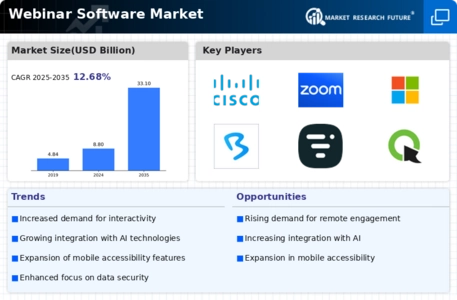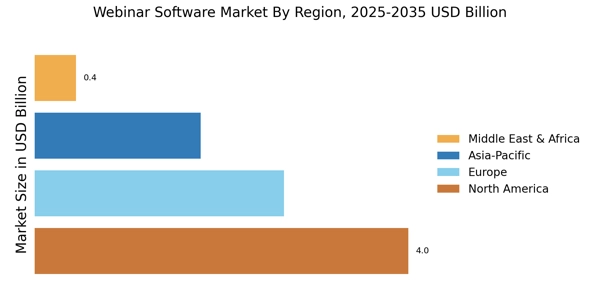Increased Focus on Interactive Features
The increased focus on interactive features within webinar platforms is a notable driver in the Webinar Software Market. As competition intensifies, software providers are enhancing their offerings with features such as polls, Q&A sessions, and breakout rooms to foster engagement. This shift towards interactivity is crucial, as studies show that interactive webinars can lead to a 50% increase in audience retention. Consequently, organizations are more inclined to invest in webinar software that provides these capabilities, thereby driving growth in the market. The emphasis on creating engaging and participatory experiences is likely to continue shaping the Webinar Software Market in the coming years.
Expansion of Small and Medium Enterprises
The expansion of small and medium enterprises (SMEs) is a significant driver of the Webinar Software Market. As SMEs increasingly recognize the importance of digital communication tools, they are turning to webinars to reach wider audiences and promote their products or services. Recent data suggests that SMEs account for over 90% of businesses in many regions, highlighting their potential impact on market growth. This trend indicates that as more SMEs adopt webinar solutions for marketing and training purposes, the demand for user-friendly and cost-effective webinar software will likely surge. The growth of SMEs is expected to play a crucial role in shaping the future landscape of the Webinar Software Market.
Shift Towards Digital Marketing Strategies
The shift towards digital marketing strategies is another critical driver for the Webinar Software Market. Businesses are increasingly leveraging webinars as a tool for lead generation and customer engagement. Recent statistics indicate that 73% of marketers believe that webinars are the best way to generate quality leads. This trend underscores the importance of webinars in modern marketing strategies, as they provide a platform for brands to showcase their expertise and connect with potential customers. As companies continue to invest in digital marketing, the demand for effective webinar software is expected to rise, further propelling the Webinar Software Market forward.
Rising Demand for Remote Learning Solutions
The increasing demand for remote learning solutions is a pivotal driver in the Webinar Software Market. Educational institutions and corporate training programs are increasingly adopting webinars as a cost-effective method to deliver content to a dispersed audience. According to recent data, the e-learning market is projected to reach USD 375 billion by 2026, indicating a substantial growth trajectory. This trend suggests that organizations are prioritizing flexible learning environments, which in turn fuels the demand for robust webinar software. As educational institutions seek to enhance their digital offerings, the Webinar Software Market is likely to experience significant growth, driven by the need for interactive and engaging online learning experiences.
Growing Emphasis on Data Analytics and Insights
The growing emphasis on data analytics and insights is shaping the Webinar Software Market in profound ways. Organizations are increasingly recognizing the value of data-driven decision-making, and webinars provide a wealth of data regarding audience engagement and behavior. This data can be instrumental in refining marketing strategies and improving content delivery. As businesses seek to optimize their webinar performance, the demand for software that offers advanced analytics features is likely to increase. This trend indicates a shift towards more sophisticated webinar solutions that not only facilitate presentations but also provide actionable insights, thereby enhancing the overall effectiveness of the Webinar Software Market.


















Leave a Comment